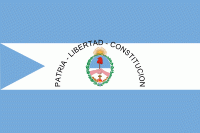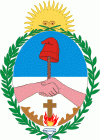Corrientes Province (Corrientes Province)
 |
 |
Before the arrival of the Spanish conquest, the Kaingang, Charrua and Guaraní lived in a big area that also covered most of the current province of Corrientes. The city of Corrientes was founded on April 3, 1588 by Juan Torres de Vera y Aragón as a mid-stop between Asunción and Buenos Aires; the city flourished thanks to the traffic from the route. Jesuits erected missions in the north of the province, where they dedicated themselves to the expansion of the faith. In the wars of independence from Spain, Corrientes joined Artigas' Liga de los Pueblos Libres (1814–1820). The attack of Paraguayan forces on the province in 1865 marked the start of the War of the Triple Alliance.
In 1919 the National University of the Littoral was founded, which in 1956 became the National University of the Northeast.
Corrientes is legendary in the world of philately for the postage stamps it issued from 1856 to 1880. These are among the very early or "classic" postage stamps of the world (the first, from Great Britain, were issued in 1840; those by the United States in 1847). The Corrientes stamps were close copies of the first issue of stamps from France, which depicted the profile head of Ceres, the Roman goddess of agriculture, and were individually crudely engraved by hand, so that each die is noticeably different, and were printed in small sheets. The first issues, from 1856 to 1860, bore the denomination in the lower panel; in 1860, the value panel was erased; the different denominations thereafter being indicated by the color of the paper used. As locally produced "primitives", the early Corrientes stamps have long been prized by collectors. After 1880, stamps of Argentina were used.
For much of the 19th and 20th centuries, politics in Corrientes were dominated by the Romero Feris family, prominent local landowners who still control most of the province's tobacco output. During most of this time, the Romero Ferises created one of Argentina's most bloated government payrolls (over 10% of total employment) and suppressed dissent and efforts at even modest land reform. Following contentious election results in 1991, however, public protest forced President Carlos Menem to remove Governor Raúl "Tato" Romero Feris from office and, though he was elected mayor of the province's capital in 1997, Romero Feris was ultimately indicted for embezzlement of public funds in 1999. He was sentenced to seven years in prison in May, 2002.
Corrientes had a significant impact in national politics in subsequent years. A UCR-led alliance defeated the Romero Feris machine in the 2001 governor's race, but the Corrientes UCR's continued support for President Néstor Kirchner led to a rebuke from the national committee of the UCR itself, and this triggered a revolt from the Corrientes chapter of the party, as well as a number of others' (notably in Mendoza Province). These differences led to the appearance that year of "K" Radicals – UCR governors and other lawmakers allied to President Kirchner.
The northeastern tip of Corrientes Province was chosen as the site for Yacyretá Dam following an agreement between President Juan Perón and Paraguayan President Alfredo Stroessner in 1974. Yacyretá, whose 20-year-long construction and US$11 billion cost far exceeded initial estimates, is one of the largest hydroelectric dams in the world. Currently, an agreement is being pursued with Paraguay which would allow reservoir expansion works that could double the facility's current installed electric capacity of 4,050 MW.
Map - Corrientes Province (Corrientes Province)
Map
Country - Argentina
 |
 |
| Flag of Argentina | |
The earliest recorded human presence in modern-day Argentina dates back to the Paleolithic period. The Inca Empire expanded to the northwest of the country in Pre-Columbian times. The country has its roots in Spanish colonization of the region during the 16th century. Argentina rose as the successor state of the Viceroyalty of the Río de la Plata, a Spanish overseas viceroyalty founded in 1776. The declaration and fight for independence (1810–1818) was followed by an extended civil war that lasted until 1861, culminating in the country's reorganization as a federation. The country thereafter enjoyed relative peace and stability, with several waves of European immigration, mainly Italians and Spaniards, radically reshaping its cultural and demographic outlook; over 60% of the population has full or partial Italian ancestry, and Argentine culture has significant connections to Italian culture.
Currency / Language
| ISO | Currency | Symbol | Significant figures |
|---|---|---|---|
| ARS | Argentine peso | $ | 2 |
| ISO | Language |
|---|---|
| EN | English language |
| FR | French language |
| DE | German language |
| GN | Guarani language |
| IT | Italian language |
| ES | Spanish language |















